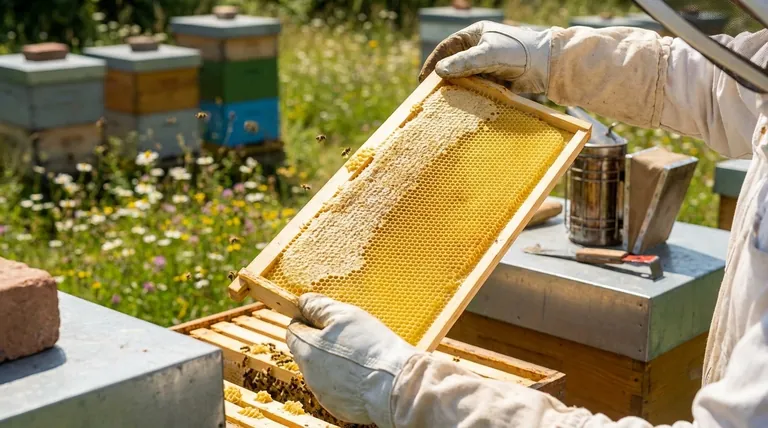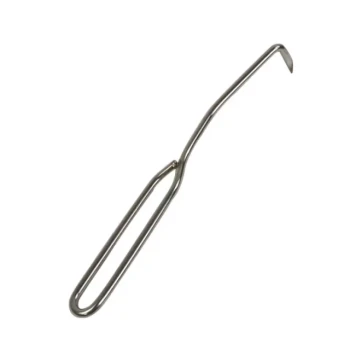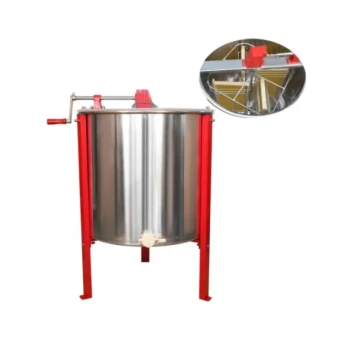In short, regular Flow Frame inspection is crucial because the frames can sustain wear and damage over time. This preventative maintenance ensures the mechanism functions correctly, prevents honey leaks, and protects the overall health and productivity of your hive.
The convenience of a Flow Hive does not eliminate the need for fundamental beekeeping practices. Viewing inspections as proactive hive management, rather than a chore, is the key to protecting your investment and ensuring the well-being of your colony.

The Core Reasons for Flow Frame Inspection
While Flow Hives brilliantly simplify honey extraction, the frames themselves are complex mechanical components operating within a dynamic, living environment. Regular checks are essential for several reasons.
Ensuring Mechanical Integrity
The plastic cells of a Flow Frame are designed to split and form channels when you turn the key. Over time, or due to mishandling, cracks or damage can occur.
A compromised frame will not operate as intended, potentially leading to an incomplete or failed honey harvest.
Preventing Honey Leaks and Waste
A small crack in a frame can become a major problem under the pressure of honey extraction. This can cause honey to leak inside the hive instead of flowing out to your collection jar.
Leaked honey can drown bees, attract pests like ants and wasps, and create a significant mess that the bees must clean up, wasting valuable time and energy.
Monitoring Bee Acceptance and Activity
Your bees are the ultimate arbiters of the hive. It's important to observe how they are interacting with the Flow Frames.
Bees use propolis (a resinous substance) to seal gaps. Excessive propolis buildup can sometimes interfere with the frame's moving parts. Inspections allow you to ensure the cells are properly capped with wax and ready for harvest.
A Practical Guide to the Inspection Process
A successful inspection is calm, organized, and minimizes disruption to the colony. Integrating frame checks into your standard hive management routine is the most effective approach.
The Role of the Frame Rest
A frame rest is a simple but invaluable tool that hangs on the side of the hive body. It provides a safe, clean, and organized place to set frames as you work.
Using a rest prevents you from placing frames on the ground where they can pick up debris or get damaged. It also helps you keep track of which frames you have already inspected.
Brood Box Inspection Remains Paramount
It is critical to remember that the Flow Frames are only in the honey super. The health of the colony—the queen, the brood, and the workers—resides in the brood box below.
Your primary inspection focus should always be the brood box. This is where you will spot signs of disease, pests, or a failing queen. A healthy brood box is the engine that powers a productive honey super.
Understanding the Trade-offs
The Flow Hive is an incredible innovation, but it is not a "set and forget" system. Understanding its limitations is key to responsible beekeeping.
The Myth of Zero-Intervention Beekeeping
The most common pitfall for new Flow Hive owners is assuming the technology replaces the need for beekeeping knowledge. The hive still faces the same challenges as any other: pests, diseases, and swarming instincts.
Regular inspections are your only way to monitor and manage these universal beekeeping challenges effectively. The Flow Hive simplifies one task—extraction—but does not eliminate the need for attentive animal husbandry.
The Risk of Over-Inspection
While inspections are vital, opening the hive is a stressful event for the colony. It disrupts their temperature regulation and defensive routines.
"Regular" does not mean "daily" or even "weekly." The frequency of your inspections should be dictated by the season, your local climate, and the specific needs of your hive. Learning to read the bees' external activity can help you decide when an internal inspection is truly necessary.
Making the Right Choice for Your Goal
Your maintenance schedule should align with your primary objective as a beekeeper.
- If your primary focus is maximizing hive health: Prioritize regular brood box inspections and only check the Flow Frames once or twice per season and before harvest.
- If your primary focus is equipment longevity: Conduct a thorough check of each Flow Frame for cracks or damage at the beginning and end of each season.
- If your primary focus is a clean, efficient harvest: A quick inspection a week or two before your planned harvest date is crucial to ensure the mechanism is clear and undamaged.
Ultimately, proactive inspection is the cornerstone of responsible beekeeping that ensures a healthy hive and a rewarding harvest.
Summary Table:
| Inspection Focus | Key Reason | Benefit |
|---|---|---|
| Mechanical Integrity | Check for cracks or damage in plastic cells. | Ensures a successful honey harvest. |
| Leak Prevention | Identify small cracks that could leak honey. | Prevents bee drownings, pests, and waste. |
| Bee Activity | Monitor propolis buildup and wax capping. | Confirms frames are ready for harvest. |
Ready to equip your apiary for success?
As a trusted supplier to commercial apiaries and beekeeping equipment distributors, HONESTBEE provides the durable, wholesale-focused supplies you need for effective hive maintenance. Ensure your operations run smoothly with our high-quality equipment.
Contact our team today to discuss your wholesale needs and protect your investment in every hive.
Visual Guide

Related Products
- Assembled Wooden Bee Frames with Beeswax Foundation Ready to Use by HONESTBEE
- 7 x Auto Bee Flow Hive Frames Plastic Beekeeping Hive Box Supplies
- Automatic Honey Flow Beehive 4 Frame Mini Hive for Beekeeping
- Precision Stainless Steel Frame Cleaner for Hive Grooves and Corners
- Professional Frame Comb Fork and Lifter for Efficient Handling
People Also Ask
- How many frames fit in a 10 frame hive? A Guide to Maximizing Your Hive's Potential
- Can I reuse old frames? A practical guide to saving money and reducing waste
- Can old bee frames be reused? Weighing the Risks vs. Rewards for Your Hive
- What are some tips for setting up hive frames? Build a Strong Foundation for Your Hive
- How do wooden frames perform during honey extraction? Superior Rigidity for a Smoother Harvest



















